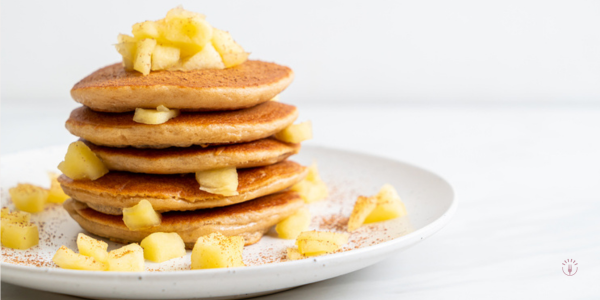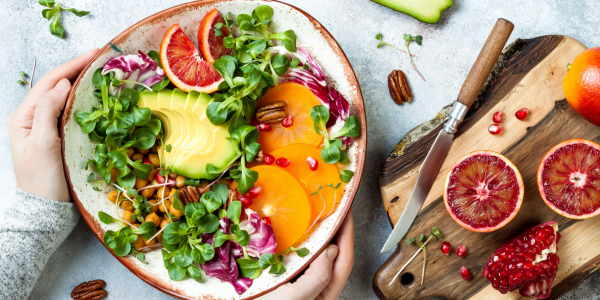
"Fat-free" or "low-fat" diet foods are often consumed in hopes to lose weight and reduce the risk of heart disease. But people often misinterpret all low-fat food as a good indicator of health.
Let it be known that fat is an integral component of a healthy diet, especially when balancing healthy fats with protein and high-fiber carb sources. And unless medically advised, restricting fat can be counterproductive to weight loss and compromise overall health.
Whether recommended a low to no-fat diet or aiming to eat healthier fat sources, add these naturally low-fat foods to your next shopping list!
Low-Fat Food List
Let it be known that not all low-fat food is created the same. Commercially produced low-fat foods often contain excess sugar and additives while naturally low-fat foods like veggies and fruits are nutrient-dense.
From whole grains to plant-based proteins, let this blueprint serve as a low-fat diet grocery list.
Whole Grains
When it comes to whole grain products, they are naturally low in fat and high in fiber and other valuable nutrients. As a general rule of thumb, include two to three servings of whole grains into a balanced diet:
• Whole grain breads, including English muffins and bagels
• Whole grain pasta and noodles, just choose red sauces or moderate-heavy creamed sauces
• All rice, though brown rice offers more fiber, protein, and other nutrients compared to white rice
• Oats and cream of wheat, just limit the butter and sugar atop
• Quinoa, which is similar to rice but also considered a complete protein source
• Corn and popcorn, just be mindful of added butter and salt
Meats and Plant-Based Proteins
Most animal products contain saturated fat. Though too much may negatively impact health, their intake is encouraged in moderated amounts and can also be low in fat:
• Lean and ground beef
• Poultry products, including chicken and turkey with skin removed
• Fish and shellfish, including cod, pollock, tilapia, and shrimp
• Eggs, especially egg whites or egg substitutes
• Beans, including black beans, chili beans, kidney beans, and pinto beans
• Lentils in all color forms
Milk and Dairy Products
Dairy products provide the body with essential nutrients that keep the body healthy. Nutritious dairy products include:
• Low-fat or skim milk
• Fat-free or part-skim cheeses, including string cheese sticks and cottage cheese
• Reduced-fat Greek yogurt, just be sure to check the nutrition and ingredient labels for added sugars
Fruits and Vegetables
Almost all fresh herbs, fruits, and veggies are naturally absent of fat. Incorporating these plant-based products contribute to a healthy low-fat diet, all while offering phytochemicals, vitamins, minerals, and other nutrients beneficial to health:
• Avocado is one of the exceptions to the fat rule, as the fruit contains high amounts of monounsaturated fat; consume in modest amounts, as they are loaded with valuable nutrients
• Vibrant berries including blueberries, strawberries, and blackberries
• Other colorful and nutrient-rich fruits including apples, bananas, and oranges
• All dark green, leafy vegetables including romaine lettuce, kale, and spinach
• Cruciferous veggies, including broccoli, cauliflower, brussels sprouts, and cabbage
• Root veggies and starches, including onions, beets, turnips, carrots, and sweet potatoes
• Vibrant herbs offer flavor without loading up on salt and sodium
Which Fats Are Recommended?
Unless directed by a healthcare provider, significantly reducing or eliminating fat is often unnecessary. The American Heart Association (AHA) recommends 25 to 35 percent of total daily calories coming from fat.
However, fats are not handled equally in the body. When it comes to dietary fat intake, various types of fat should be avoided, limited, and used more often based on their function.
Avoid: Trans Fats
With such negative consequences on health, it is no wonder why the United States Food and Drug Administration (FDA) declared the elimination of trans fat in the food supply.
Besides, the AHA advises reducing trans fat intake to less than 1 percent, as their intake can lower HDL levels, raise LDL levels, and increase the risk of developing heart disease and stroke.
Trans fats can be identified as hydrogenated or partially hydrogenated oils and are often found in a wide variety of convenience and commercially prepared products, including fried foods, chips, pastries, and donuts.
Limit: Saturated Fats
Despite popular belief, saturated fat products can fit into a well-balanced diet. The importance, though, is keeping their intake in modest amounts and sticking to serving sizes.
The AHA advises reducing saturated fats to less than 5 to 6 percent. Healthful saturated fat products include most dairy products, beef, eggs, and coconut oil.
Use More of: Monounsaturated and Polyunsaturated Fats
The majority of fat consumption should ideally come from those "healthy" unsaturated fats. More specifically, monounsaturated fatty acids (MUFAs) and polyunsaturated fatty acids (PUFAs).
Swapping out trans and saturated fats with MUFAs and PUFAs can offer satiety while protecting from heart disease and chronic inflammation in the body.
Monounsaturated fat comes from high-fat foods like avocados, nuts, and their correlated nut butters. MUFAs are also vegetable oils including canola and olive oils while PUFAs are further broken down into omega-3 fatty acids and omega-6 fatty acids.
Omega-3s are highly recognized in the literature for their antioxidant and heart-protective properties. Sources include seed oils, chia seeds, tofu, and fatty fish including herring, tuna, salmon, and trout.
Low-Fat Diet Menu Ideas
Need a little inspiration using the low-fat food list? We have you covered! Stick to a low-fat diet with a few of these well-balanced, flavor-filled meal ideas.
Yogurt Parfaits
Instead of convenience yogurts and parfaits loaded with fat and sugar, create your own at home! Layer plain Greek yogurt with fresh berries, oats, and a light drizzle of your favorite nut butter.
The breakfast or snack combination is heart-protective and protein-rich to keep you satisfied for hours!
Overnight Oats
Oats are a naturally low-fat food and packed with beneficial nutrients like dietary fiber, plant-based protein, and B vitamins.
For a quick, nutrient-dense breakfast option, add overnight oats to any low-fat diet menu. Personalize flavors by adding and topping with fresh fruit, Greek yogurt, chia seeds, and other favorite oatmeal pairings.
Variety of Salads
Salads often scream health but can actually be packed with grams of fat, unwanted sugar, and more. This is mostly due to toppings like fatty cuts of meat, cheese, croutons, and salad dressings.
Create a healthy salad by first selecting a leafy base then garnishing with additional produce. If eating as a main dish, balance with a lean protein source then dress with fresh flavors like olive oil, lemon juice, and seasonings or a homemade salad dressing.
Beef and Broccoli Stir-Fry
Create an Asian-inspired dish without all the added calories from fat-laden and sugary sauces with this beef and broccoli recipe.
Prepare a lean cut of beef to desired internal temperature (well, medium-well, etc.) and mix into steamed broccoli and brown rice or quinoa. Drizzle with soy sauce and top with chopped scallions and peanuts.
Vegetarian Chili
Chili is a fiber and protein powerhouse, even without ground meat! (But also feel free to use a leaner source like ground turkey or chicken.)
Skip out on the beef and turkey and use strictly beans including chili and kidney beans. Add favorite chili seasoning and throw in fresh tomatoes and other chopped and diced veggies for added nutrients!
Fish Tacos
Fish and shellfish contain those healthy fats along with ample amounts of protein all at a low-calorie cost.
Use a whole grain tortilla and layer fish, fresh tomatoes and lettuce, a dollop of plain Greek yogurt, fresh cilantro, and a squeeze of fresh lime juice!
Recapping Low-Fat Diet Foods
Let it be known healthy eating is not synonymous with low-fat foods. However, including more wholesome, low-fat foods can be helpful for paving the way to a healthier eating pattern.
A natural low-fat food list features nutritious whole grains, fruits, vegetables, and lean proteins. Unless medically advised, though, one should not exclude fats entirely. Add more healthy fats, including fatty fish, nuts, and seeds, for maximum health benefits.







